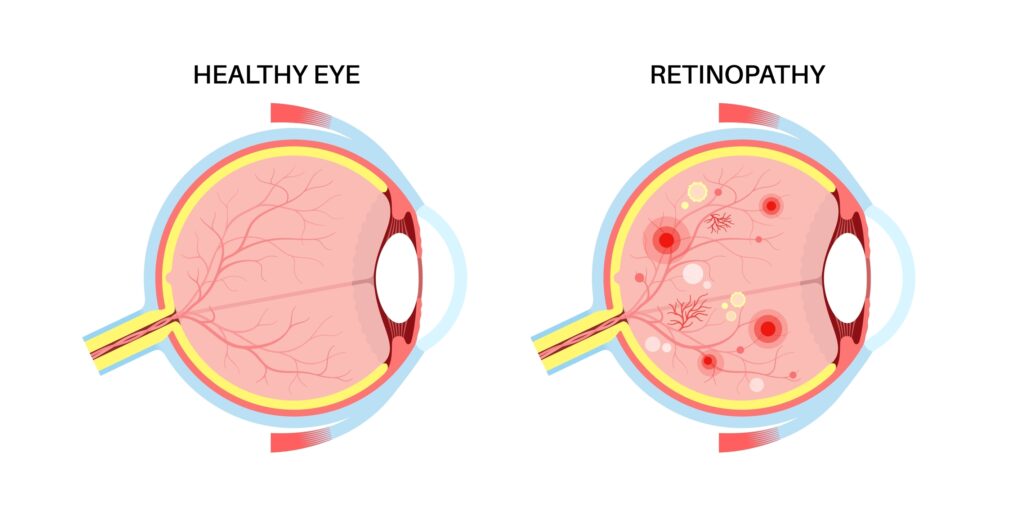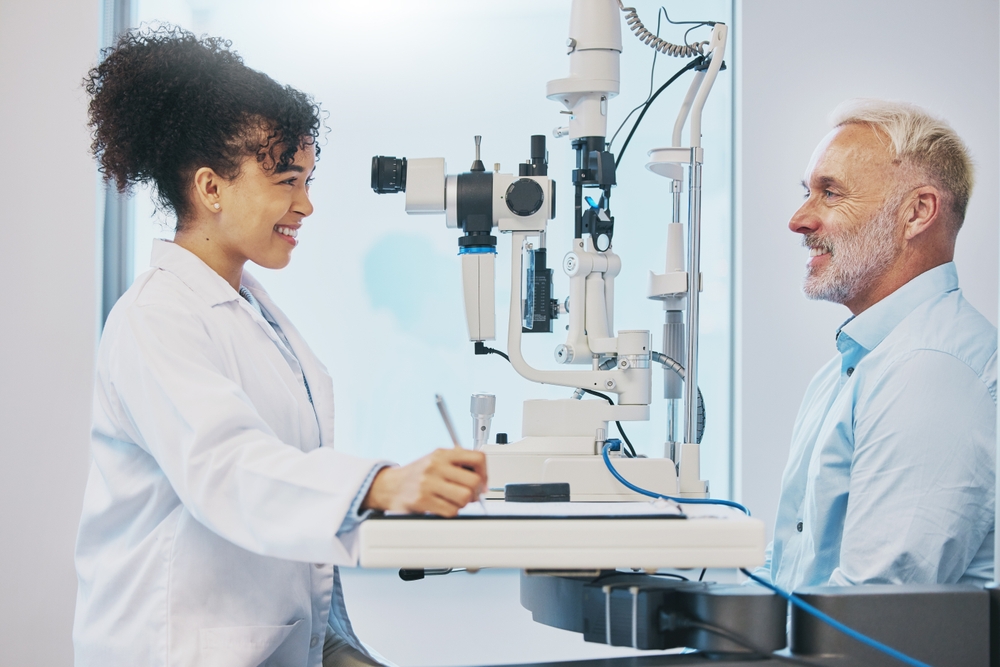Did you know that diabetes can have a significant impact on eye health? In some cases, these complications can lead to eye conditions that have the potential to result in complete loss of sight.
The best way to prevent vision loss with diabetes is to schedule regular eye exams with an ophthalmologist. Keep reading to learn more about how diabetes can affect eye health and how often patients with diabetes should see an ophthalmologist.
How Does Diabetes Affect The Eyes?

Diabetes is a health condition characterized by high levels of blood glucose, also known as blood sugar. Blood glucose fuels the body’s cells and is regulated by insulin, a hormone produced by the pancreas.
When the body doesn’t produce enough insulin, glucose remains in the blood and is unable to reach the cells. Excessive glucose causes damage to both small and large blood vessels, making them stiff and narrow.
Diabetes affects the eyes by damaging the tiny blood vessels in the structures of the eye. High levels of glucose in the blood vessels of the eye can cause them to swell and leak fluid and blood, prevent nutrients from reaching eye cells, and increase pressure within the eye.
What Eye Conditions Can Diabetes Cause?
The effects that diabetes has on the blood vessels within the eye put patients with diabetes at a higher risk of developing these eye conditions:
Diabetic Retinopathy

Diabetic retinopathy is caused by damage to the vessels of the retina, the structure within the eye that detects light and transmits visual images to the brain via the optic nerve. High levels of glucose in the blood cause the vessels in the retina to become blocked and start leaking, increasing pressure on the retina.
As the retina’s primary vessels are damaged, new blood vessels may grow, but these secondary blood vessels are often abnormal and prone to leakage. This can lead to blurry vision, dark spots, and even blindness.
Macular Edema
Macular edema is a secondary eye condition that can be caused by diabetic retinopathy. This condition occurs when leaking blood vessels cause swelling of the macula, the structure of the eye responsible for central vision, color vision, and visual acuity.
Excessive swelling of the macula can impair the retina’s ability to focus properly. It is a common cause of severely blurry vision among people with diabetes.
Glaucoma
Diabetes doubles the risk of developing glaucoma, a condition in which elevated levels of intraocular pressure damage the optic nerve. That pressure is usually the result of leakage from damaged or abnormal blood vessels blocking the eyes’ drainage canals.
Glaucoma initially affects peripheral vision, causing blind spots or tunnel vision. Damage to the optic nerve is irreversible and can lead to blindness.
Cataracts
Patients with diabetes are also at a higher risk of developing cataracts or developing them at an earlier age. High blood glucose levels can affect the lens of the eye, causing it to swell and release proteins that clump together on the lens.
This is because the lens of the eye has an enzyme that converts glucose to a substance called sorbitol. When sorbitol collects on the lens, it can affect its cells and naturally occurring proteins, causing the lens to become cloudy.
Dry Eye
Approximately 56% of individuals with diabetes experience chronic dry eye. Uncontrolled levels of glucose in the blood can damage the lacrimal glands, which produce the aqueous layer of tears, and reduce tear production.
It can also cause damage to the meibomian glands, which produce the lipid or oily layer of tears. Lack of oil in tears can cause dryness by allowing tears to evaporate too quickly.
How Often Should Patients with Diabetes See an Ophthalmologist?

Individuals with diabetes typically require more frequent visits to an ophthalmologist than most people. Comprehensive eye exams are critical for the early detection and treatment of diabetes-related eye conditions.
Most people with diabetes should see an ophthalmologist at least once a year. When annual exams should start can depend on the type of diabetes a person is diagnosed with.
For individuals with type 1 diabetes, yearly exams may not be needed until a few years after their initial diagnosis. An individual with type 2 diabetes often needs both an immediate eye exam and annual exams upon diagnosis, as eye damage may have already occurred.
If an ophthalmologist finds signs of a diabetic eye condition, they may recommend a comprehensive eye exam every three to six months to monitor its progression. More frequent exams can lead to more timely treatment and reduce the risk of vision loss.
Pregnant women with diabetes should have an eye exam during their first and third trimesters, as pregnancy can accelerate the progression of diabetic retinopathy. Women who develop gestational diabetes during pregnancy should also have an eye exam during their pregnancy and after they have given birth.
What Happens During a Diabetic Eye Exam?
A diabetic eye exam is similar to a regular comprehensive eye exam, but an ophthalmologist may conduct a more intensive examination of the structures within the eye. These exams typically include a dilated eye exam, during which special eye drops are used to dilate the pupils for a clearer view of the retina, macula, and optic nerve, allowing for the detection of signs of diabetic retinopathy, macular edema, and other eye conditions.
Diabetes-related eye conditions are one of the most common complications of the disease, but they do not have to result in vision loss. Ophthalmologists are specially trained to identify the signs of these conditions and offer treatments that can slow their progression and protect clear vision.
Do you have diabetes? Stay on top of your eye health by scheduling a diabetic eye exam at Batra Vision in San Leandro, CA, today!

 Follow Us!
Follow Us!